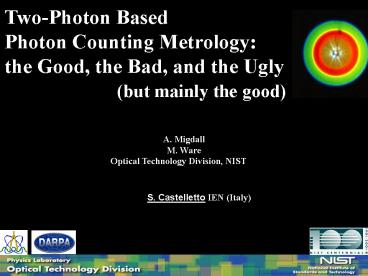TwoPhoton Based - PowerPoint PPT Presentation
1 / 29
Title:
TwoPhoton Based
Description:
Dark counts. Scattered light. Quantifying Level of ... Electronic Collection. Map coincidence timing jitter. Dark count determination (trigger detector) ... – PowerPoint PPT presentation
Number of Views:26
Avg rating:3.0/5.0
Title: TwoPhoton Based
1
Two-Photon Based Photon Counting Metrology the
Good, the Bad, and the Ugly
(but mainly the good)
A. Migdall M. Ware Optical Technology Division,
NIST
S. Castelletto IEN (Italy)
2
Photon Counting Metrology with Two-Photon
Sources How it works What it can do and do
better than traditional (Good) Details of
turning it into metrology (Bad) Real world
detectors (Ugly) Future Vision
3
Optical Parametric Downconversion One in - two out
4
Optical Parametric Downconversion
5
(No Transcript)
6
(No Transcript)
7
(No Transcript)
8
Detector Quantum Efficiency Scheme No
External Standards Needed!
Detector to be Calibrated
Trigger or Herald Detector
First PDC demo - Burnham Weinburg 1970
9
What it does best - (the Good)
10
Absolute Light Source
Output characteristics photon ?
known photon timing ? known wavelength ?
known direction ? known polarization ? known
11
Absolute Radiometric Source Standards
12
Detector Quantum Efficiency Scheme Spectral
selectivity NOT placed in DUT path
Detector to be Calibrated
Visible trigger detector visible filter to
calibrate IR detector
13
What it does best - (the Good) Inherently
absolute Primary Standard method (it is an
absolute light source, also) Can disseminate
the method Direct tie to local primary
standard (short calibration chain) Direct
measurements in photon counting
regime (Attenuator transmittance uncerts.
0.3-2 for ODs7-10) Spectral
tunability Spectral selective element need not
be in DUT path (IR calibrations with visible
hardware) Autocorrelation version One detector
as DUT and trigger Czitrovszky et al,
Metrologia 37, 617, (2000) Convenience
improving with solid state lasers downconvers
ion sources
14
Details of turning it into metrology
(Bad) (Verifying results and uncertainties)
15
Requirements of a Primary Standard
technique Measurement Confidence
Measurement protocol Internal self consistency
tests to verify correct operation Does the
result depend on parameters as expected? Is
setup really understood? External
tests Intra-lab comparisons correlated/conventio
nal Requires range where both methods work
well Least accurate method limits comparison
Inter-lab comparisons correlated/correlated D
ifferent measurement setups (e.g. different
downconversion crystals) Suitable sample
detector (photon counting) Requires Stability
of efficiency, dark counts, thresholds,
electronics, spatial uniformity spectrally
smooth response Convenience, portability
16
Measurement protocol- Internal tests Verify
certainty of collection of photons correlated to
trigger DUT Optical path transmittance losses
(crystal) Calculations Measurements (possibly
in situ) DUT Collection Efficiencies Spatial
Angular Spectral Electronic Verify
certainty of trigger count rate Trigger
Backgrounds Dark counts Scattered light
17
Quantifying Level of Collection Losses
18
(No Transcript)
19
Testing Self-Consistency
20
(No Transcript)
21
(No Transcript)
22
Proposed Protocol Philosophy Design for
minimum losses Verify uncertainties of whats
left Optical System Design Minimize crystal
losses Minimize loss in crystal to detector
path Minimize angular spreading of correlated
photons Self Tests- Geometric
Collection Positioning of detector and
collection optics Collection aperture
size Electronic Collection Map coincidence
timing jitter Dark count determination (trigger
detector)
23
Real world detectors (Ugly)
24
Detector Funny Business
25
(No Transcript)
26
APD Module Output Pulse Delay variation with
count rate www.Becker-Hickl.com
50 KHz
50 KHz
500 KHz
500 KHz
Counts
l650 nm
l405 nm
0
1
2
3
4
5
0
1
2
3
4
5
Time (ns)
Time (ns)
27
Estimated Uncertainties
Rel. uncert.
Value
Inherent in Technique Crystal Transmittance
(half) 96.0 0.054 - 1 surface reflectance
4.0 0.02 - internal
transmittance 99.9 0.05 Geometric
Collections Effic. 99.8 lt0.25 Coincidence
Counting 99.9 0.1 Included with DUT Filter
transmittance 80.0 0.8 Lens
transmittance 99.8 0.4 Detector
stability 0.1 lt0.1 Spatial
uniformity 50. 0.5 ? Values achieved so far
Method Total
0.27
DUT Total
1.0
Current tests are limited by DUT uncertainties
28
Goal/Vision for NISTs role- This is a
Primary Standard Method Emphasize
dissemination of the method rather than
Routine NIST calibration facility Keys-
Measurement Protocol Self consistency tests
to verify uncertainties Intercomparisons Design
aids for Down Conversion Sources
http//physics.nist.gov/Divisions/Div844/facilitie
s/cprad/cprad.html Cost effective measurement
systems e.g. all solid state photon
pair source Volz, Kurtsiefer, Weinfurter Apl.
Phys. Letts. 79, 869(2001) Better detectors
needed - (better measurements may facilitate this)
29
The End































